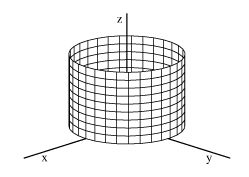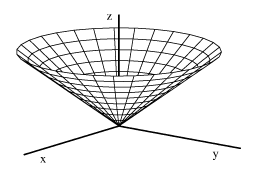|
|
|
|
|
|
Surfaces are the analog in space of curves in the plane. When you think of "surface," several familiar objects may come to mind. Spheres, cylinders, and planes are all surfaces, but is a cone -- with its sharp point -- a surface? We will consider several classes of surfaces in this module and try to give at least an intuitive answer to the question "What is a surface?"
In the xy-plane, a single
equation in either or both variables usually represents a curve of some sort
-- a one-dimensional object. In Cartesian coordinates, if we set one of the
coordinates equal to a constant, the resulting "curves" are horizontal
and vertical lines. In polar coordinates, r = constant represents
a circle, and ![]() = constant
represents a ray emanating from the origin.
= constant
represents a ray emanating from the origin.
In space, the simple equations obtained by setting a coordinate equal to a constant represent surfaces. In Cartesian coordinates, setting any of the three coordinates equal to a constant c defines a plane in space.
In cylindrical coordinates, the surface
r = c is a cylinder (left-hand figure below), and ![]() = c
defines a plane through the vertical axis (right-hand figure -- negative
values of r give the part of the plane on the other side of the z-axis).
= c
defines a plane through the vertical axis (right-hand figure -- negative
values of r give the part of the plane on the other side of the z-axis).
 |
 |
In spherical coordinates, we get
spheres by setting  = c (left
figure below). Setting
= c (left
figure below). Setting ![]() = c
is the same as for cylindrical coordinates, except
= c
is the same as for cylindrical coordinates, except ![]() never takes negative values. Finally, setting
never takes negative values. Finally, setting  = c
defines a cone at the origin as in the right figure below.
= c
defines a cone at the origin as in the right figure below.
 |
 |
 = 4,
= 4,
 = 1
in spherical coordinates.
= 1
in spherical coordinates.
 = c
in spherical coordinates.
= c
in spherical coordinates.
|
|
|
| CCP Home | Materials | Multivariable Calculus | Module Contents | Back | Forward |
modules at math.duke.edu
Copyright
CCP and the author(s), 2001-2002